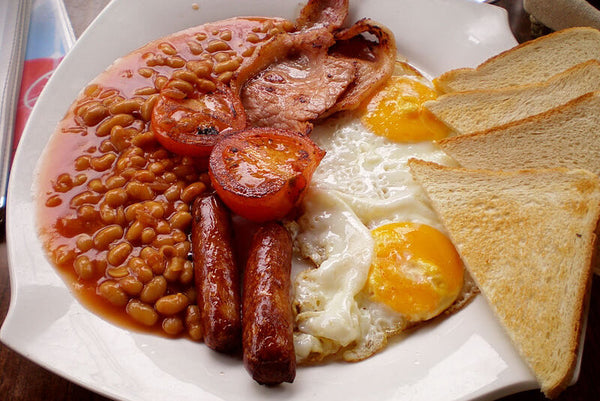Our love affair through the ages with the full English
By Ali Graham, Medium Well

Is there a more glorious feeling than waking up to the smell of frying bacon? If you’re thinking no, you’re thinking too small… it’s better to wake up to the smell of a full English.
Booming to popularity during the Victorian era, we’re now all very familiar with the beautiful sight of the piled high sausages, bacon rashers, fried or scrambled eggs, hash browns, baked beans, grilled tomatoes, toasted or fried bread slices, fried mushrooms and maybe even a slice of black pudding for good measure.
You’ve all had one, so I bet all of you just pictured this iconic British dish in your heads and got a craving for a proper fry up. Recently, our beloved breakfast has seen a rise in popularity despite the increasing number of us visiting gyms and people taking our health more seriously. It’s not the first challenge the full English has faced over the years; the dish has had a tumultuous time since it first reached the masses. We decided to take a look back at its history to understand where our deep love of the fry up comes from.
The dish has come quite a long way since the mid 1800s when kidneys on toast, pheasant legs and pig cheeks were a common feature, but there’s still a lot of variation. The Scot’s add ‘tattie’ scones and occasionally a slice of haggis, those in the North Midlands opt for oatcakes instead of fried bread, the Welsh add laverbread (that’s seaweed), and the Irish include hog’s pudding and fried potatoes. Whichever variation you go for, there’s really no beating a good English fry up.
Having a cooked breakfast was a novelty at first – the first cook books to reference the dish were written around 1860. As the availability of ingredients became more widespread, the full English became available to all classes who could afford a trip to their butcher.
When WW2 happened, rationing happened. It was so long, farewell to the English breakfast as the salty, meaty goodness of sausages and bacon became a distant memory and cooked breakfasts were effectively restricted to a few slices of toast and the occasional boiled egg. Bleak times, eh.
After we won the war and the rationing ceased, it was like we were suddenly in full Technicolour again, except Technicolour for our taste buds.
Because we were so rationed, we had a more modest approach to returning to our old favourites. We still treasured our old full English ingredients, so much so that we restricted ourselves – this was a treasure to be given respect – so we ended up reserving this special dish for the weekends.
Through the 20th century we fell in and out of love with the full English, we had periods where everyone was just too busy. Morning meals were simplified down to cereals, and then to biscuits in more recent times – the time to stand over a hob to do a fry up was just a thing of the past for a lot of us.
And now? We’re a society obsessed with healthy living. We’ve had scary headlines pushed in our faces for years about the dangers of salt, fat and fried foods and the outcome of clotted arteries and heart disease – and it’s understandable to be scared of those.
But we’re getting savvy, we’re spending more time prepping our food and understanding what goes into it, and we’re figuring out that great tasting food can be really good for us too.
And so returns the weekend favourite. We’ve learned that good quality meat and produce doesn’t interfere with our healthy lifestyles – not to mention, it tastes way better.
Long live the full English!